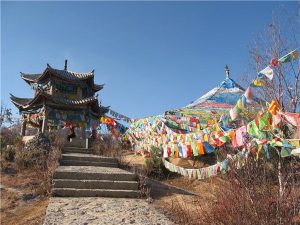Baiji Monastery in Shangrila
Attraction Overview
With a history of several hundred years, Baiji Temple is translated to 100 chickens temple as there are many chickens running around the temple grounds. It also offers great views of the town and surrounding mountains.
Attraction Type:Buddhist Monasteries & Temples
Chinese Name: 百鸡寺(Pinyin: Baijisi)
Best Time to Visit: All-year-round
Recommended Visiting Time: 1 Hour
Open Hours: All Day Long
Admission Fee: Free
Location: Dukezhong Ancient Town, Shangrila, Diqing Prefecture, Yunnan
History and Culture
Built in Yuan Dynasty, Baiji Temple, also called one hundred chicken temple, has a history of several hundred years. It’s located atop an even higher hill about one kilometer southwest of Guishan Park, with seven evergreen hundred-year-old trees standing in front of its door. It offers an amazing bird’s eye view of the ancient town and the surrounding city.
Baiji Temple is popular among local Buddhism believers. On the first and the fifteenth day of every lunar month, many believers coming for blessing. To redeem their wish, a chicken will be brought and released up on the hill. That’s how it got the name “one hundred chicken temple”. When the east turns white, the cock calls in unison, awakening the sleepy ancient city, people of all nationalities begin another busy day…
How to Get there
From Dukezong Ancient Town, tourists can walk to it. The walk to get there is also quite spectacular, as the hill is covered with thousands of Tibetan prayer flags.
Attractions Nearby
Guishan Park: Built in the reign of emperor Kangxi, the park is built leaning the hill. Chaoyanglou, standing on top of it, has three floors and at the top floor of the building people can have a panoramic view of the Dukezong Ancient Town. At the foot of hill, there is an ancient well providing drink water for the townspeople.

Giant Prayer Wheel: The giant prayer wheel in Shangrila is reputed as the largest one in the world for its 21 meters in height and 60 tonnes in weight. Because of its size and weight, the prayer wheel is to be spun by multiple people. It’s a must-see attraction of Shangrila tour.
Moon Square: At the north side of Moon Square stand Diqing Red Army Long March Museum(open time: 10:00 – 17: 00) and Diqing Museum(08: 30 – 18: 00) which deserve a visiting.
Square Street: Square Street, at the heart center of the old town, is the main tour area gathering a maze of cobbled lanes, white stupas, renovated tourist shops, café, bars, etc. Further away from the square street, the narrow winding lanes will give you a quieter shelter and unveil you more authentic local touch with the unrestored structures and real local life. The main town square is a snack and bauble market during daytime and a lively dancing place for Tibetan locals at night.

 7 Days GolfingTour
7 Days GolfingTour
 8 Days Group Tour
8 Days Group Tour
 8 Days Yunnan Tour
8 Days Yunnan Tour
 7 Days Shangri La Hiking
7 Days Shangri La Hiking
 11 Days Yunnan Tour
11 Days Yunnan Tour
 6 Days Yuanyang Terraces
6 Days Yuanyang Terraces
 11 Days Yunnan Tour
11 Days Yunnan Tour
 8 Days South Yunnan
8 Days South Yunnan
 7 Days Tea Tour
7 Days Tea Tour
 8 Days Muslim Tour
8 Days Muslim Tour
 12 Days Self-Driving
12 Days Self-Driving
 4 Days Haba Climbing
4 Days Haba Climbing
 Tiger Leaping Gorge
Tiger Leaping Gorge
 Stone Forest
Stone Forest
 Yunnan-Tibet
Yunnan-Tibet
 Hani Rice Terraces
Hani Rice Terraces
 Kunming
Kunming
 Lijiang
Lijiang
 Shangri-la
Shangri-la
 Dali
Dali
 XishuangBanna
XishuangBanna
 Honghe
Honghe
 Kunming
Kunming
 Lijiang
Lijiang
 Shangri-la
Shangri-la
 Yuanyang Rice Terraces
Yuanyang Rice Terraces
 Nujiang
Nujiang
 XishuangBanna
XishuangBanna
 Spring City Golf
Spring City Golf
 Snow Mountain Golf
Snow Mountain Golf
 Stone Mountain Golf
Stone Mountain Golf














